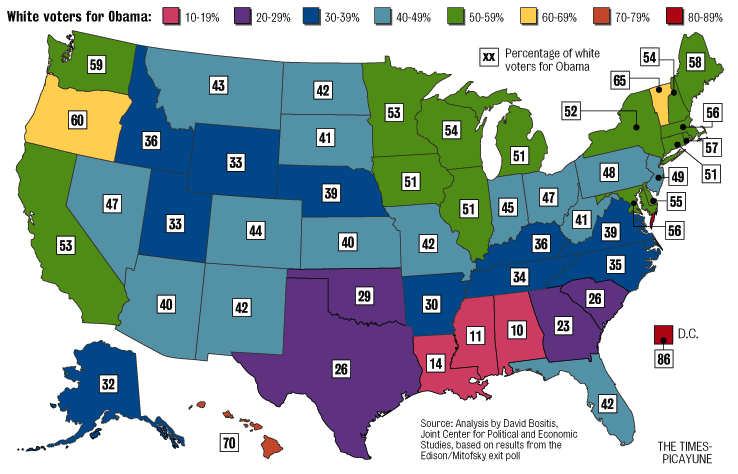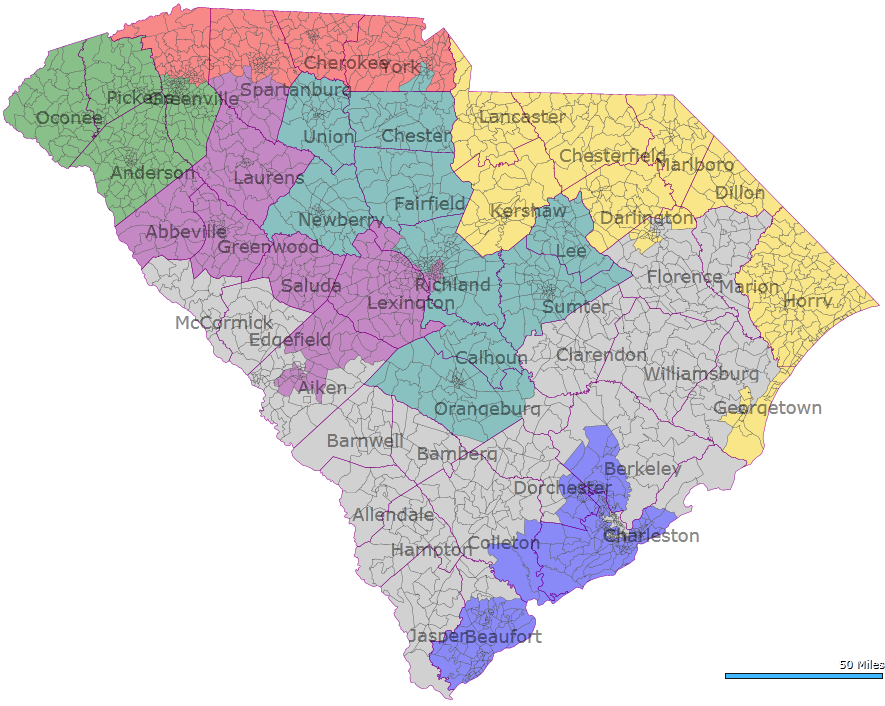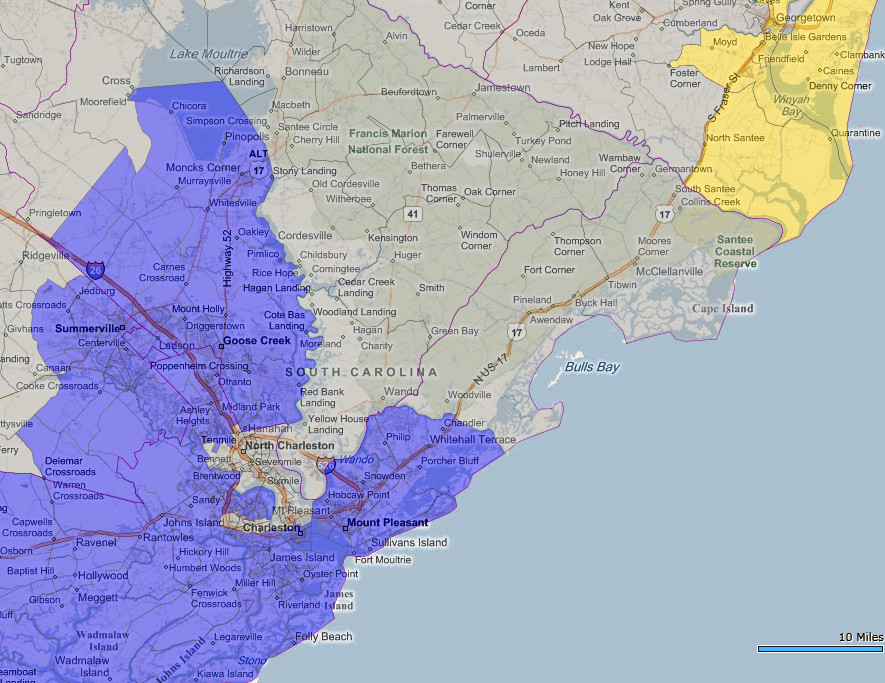After the recent election, Democrats will now hold only one out of six seats in South Carolina — the black-majority SC-6. With the upcoming reapportionment, the state is slated to add one seat. I believe that under the Voting Rights Act, the Department of Justice should push hard to make sure that the new South Carolina seat is a black-majority district — as long as the new seat is drawn to be compact. Frankly, in the case of South Carolina and several other states in the “Deep South”, I think the only way to have another Democratic representative there is to draw another black-majority seat.
Source: http://www.nola.com/news/index…
Over a year ago, I drew a plan for Louisiana where an additional compact black-majority seat is added (even as the state is set to lose one of its seats):
link is here — http://www.swingstateproject.c…
Fortunately, it appears that it would be quite easy to draw an additional seat in South Carolina that is also compact. In this diary I have drawn two versions of a map: the first produces two seats that are both at least 55% black, while the second version has two seats that are at least 51% black. I think that both would pass under VRA and DOJ requirements. Version 1 is a little more creative, but certainly no more so than existing districts like FL-3 or NC-12. Version 2 is more strict in criteria like following county lines and would easily pass muster. Dave’s Application does not appear to have partisan breakdowns for South Carolina, but my “guestimates” for the two new black districts are approximately 62-63% Obama under Version 1, and 58-59% Obama under Version 2.
VERSION 1:
District 1: Blue — 73% white; 18% black
District 2: Violet — 77% white; 17% black
District 3: Green — 76% white; 17% black
District 4: Red — 79% white; 13% black
District 5: Yellow — 73% white; 21% black
District 6: Gray — 55% black; 40% white
District 7: Teal — 56% black; 38% white
VERSION 2:
District 1: Blue — 72% white; 19% black
District 2: Violet — 75% white; 19% black
District 3: Green — 76% white; 17% black
District 4: Red — 76% white; 16% black
District 5: Yellow — 70% white; 24% black
District 6: Gray — 51% black; 44% white
District 7: Teal — 51% black; 43% white





in the redistricting process-especially with VRA. The two big wild cards in the 2010 cycle will the Obama Justice department and the Surpreme court.
1. In the last two redistricting cycles Sandra Day-more or less-set the standards for districts. What will the new lineup do? The Liberal justices will tend to look for minority districts while the conservative justices (broadly speaking) defer to legislatively drawn seats.
2. What will the civil rights wing of DOJ do? In Florida if they defer to state law and not contest Prop 20/22 which supposely is race neutral. How can they contest legislatevely drawn districts that are race neutral? The DOJ can’t go to court to force second AA seats in SC & AL but allow Florida to draw lines without considering Race.
I have no particular insight as to what the GOP will do in SC but here’s my general sense of what their lines will be. Joe Wilson-ironically needs to be made more secure. A lot of the growth has been coastal or Greenville/Peidmont area. So without drawing maps I suspect we see Wilson lose his part of Richland county plus he will snag a little rural part of the 6th plus the rest of Aiken and a piece of Edgewood.
The new GOP seat will take Wesstern Richland-the western part of the current 5th plus 150K left over from the 4th.
The 5th will slide down to take Horry- while the 6th & 1st remain mostly the same except for Horry being gone.
This is a general configuration. I defer to the map makers.
I might add that Tim Scott-the AA GOP congressman from Charleston is almost wolfbane in any VRA discussion in SC. His very presence says to the courts & DOJ that your old ideas that white folks will not vote for AA candidates is old school.
I couldn’t get it compact at all. You did a good job of keep them both compact.
I think the First District would end up being a problem long term for Republicans. Charleston County is trending Democratic, Sheheen won it by three points in the Gubernatorial this year. Even when the African-American precincts are in another district, you still have trend, which is why Linda Ketner did so well in 2008. Pairing it with Beaufort County makes it weaker than the current version, because Beaufort isn’t as strongly GOP as Horry, which is what keeps SC-1 safe for Republicans. I don’t know if the Republicans would gamble with the seat like this.
There are three sources of congressional lines
1. Legislative bodies
2. State courts
3. Federal courts
I am no constitutional lawyer but you have to show me in the law where the DOJ “must” draw additional majority minority seats. You give the impression that the DOJ has the power to impose its views in this matter when in fact its just another interested party and while it has the job of preclearing its views on the matter carry (in the court of law) the same weight of the state.
The DOJ can advocate the creation of additional seats or seat and must pre clear but the drawing of seats is left to either federal or state courts. In VRA matters the lawsuit may start in state but eventually ends up in Federal courts.
I might add that in the last cycle of cases the courts deferred to legislative bodies more often then not. I also believe that the courts will look for consistent application of VRA matters within the total number of states. I might also add that voting pattens and the election of minority candidates in minority/majority districts have been discussed in court rulings. I don’t think its insignificant that say Bishop in GA2 has won election in a 47%AA district or that Scott has won election in a 30%AA district.
Great way to piss off congressional Democrats and the minority voters who propelled him into office because they thought he’d stand up for their interests.
I think he’ll direct Atty. Gen. Holder and the DoJ to get tough on states in the South and Southwest to draw minority-majority districts where reasonably possible.
and the matter of local interests.
1. The GOP draws a district for Scott that includes all of Charleston County (he is only missing a small 60%AA spot now of that county)plus the mostly GOP parts of Berkley & Dorchester plus the Coastal parts of Georgetown. Then enough of Horry (probably 80K or so) to get to equal population standards
2. With of all of Charleston minus the Horry part the district is about 22% AA and will be a 60% Bush (based on 2004 votes) district. That should be safe GOP unless its a wave year.
3. Unfortunely without the 100K of AA’s in Charleston its impossible to get to 55% minority in the second minority district for SC. The GOP could argue that Charleston needs to stay intact to provide an electoral home base for AA Scott. You draw a nice safe republican district for someone in the Charleston area but you remove over 1/2 of Scott’s voters. So as I said earlier you make the courts decide to decimate one AA congressman’s seat to create another AA seat for someone else.
You cannot predict what the courts will do. By my math the current estimates for SC is 28.2% AA which is still less then 2/7’s of the state’s population.
involved in the adjustment of lines by the court of appeals in TX. Some of the points related to 55% hispanic population and in the case of the lines for TX25 there was a question of how far from Austin TX much of the district was.
The court did not address the political party that congressman Bonilla belonged to. In fact more of Bonilla’s home area of Bexar county was added to the district. It made the district more hispanic and democratic but Bonilla’s home area was perserved. My contention that perserving Scott’s home area would be right in line with that court ruling.
The court in the Texas case was very aware of home area of each congressman involved. Ironically it helped Doggett but hurt Bonilla. I still contend that courts may very well take into Scott’s race and where his home area is.
I also acknowledge your points and that you could be very correct.
is that’s a matter of dispute. Is the purpose to pack minorities into districts to elect one democrat when splitting AA populations might elect two democrats? Which plan looks after the interest of the minority voter?
Does the VRA say 55%? If you can create a 55% district must you?
I know what the law says but its roadmap with all sorts of judicial precedence floating around.
I know this thread is about redistricting South Carolina, but I have to say looking at that map, its still pretty amazing for all the talk about Obama’s problems with Appalachian voters that a higher percentage of whites voted for Obama in West Virginia then in states he won like Virginia and North Carolina, and almost as many as voted for him in Florida.
MI-06 (home), MI-02 (college)
I noticed this about your maps, though this is a tangent.
You moved Greenville and Southern Greenville County from District #4 to District #3. Right now, hard right Republicans win by 2-1 margins in both districts, I think because Republican politics in this part of SC is especially hardline and the Dem party here is moribund. But in moving Greenville to #3, are you concentrating the state’s hardest right wing voters into just one district?
seem hard to believe mathematically. Obama won 56% of the white vote in Maryland? He won 90%+, of course, among the 30%+ of the state which is black. How does that get him to 62%? Similarly, in 20%+ black Delaware, I can’t believe that Obama could only get 62% total if he got 55% of the white vote. I’m sorry but I wonder if these are about as reliable as the exit poll showing AAs as 26% of the NC 2004 electorate.